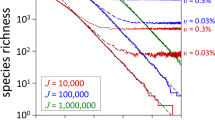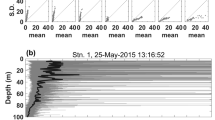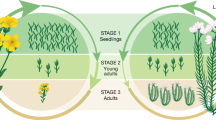Abstract
How can we explain the biodiversity of rainforests and coral reefs if we do not understand the species diversity of phytoplankton in a droplet of water1? In our attempt2 to solve the plankton paradox, we showed that multispecies competition may generate oscillations and chaos and that these fluctuations create opportunities for the coexistence of many species. Lundberg et al. question the novelty of our findings and argue that the plankton paradox was resolved 25 years ago.
Similar content being viewed by others
Huisman and Weissing reply
The earlier findings3,4,5 quoted by Lundberg et al. are interesting because they show that multiple species can coexist on a single biotic resource. However, biotic resources are irrelevant to an explanation of the plankton paradox. This paradox is concerned with phytoplankton1, and phytoplankton species do not compete for biotic resources — they use abiotic resources such as nitrogen, phosphorus, silicon, iron and light.
Also, the mechanisms that generate the fluctuations differ. The models to which Lundberg et al. refer consider predators competing for biotic prey. It is well known that predator–prey interactions easily generate fluctuations6. The fluctuations that we investigated, however, are not predator–prey oscillations. We discovered that models of competition for abiotic resources2,7 may also generate fluctuations, and that these competitive fluctuations allow a high species diversity. We have therefore shown that competition itself can generate the fluctuations that favour species coexistence. This resolves the plankton paradox.
Apart from these differences with the earlier findings3,4,5 in terms of the type of resource and the source of the fluctuations, there is an important similarity, as pointed out by Lundberg et al. All of these studies indicate that non-equilibrium dynamics generated by species interactions can have a major impact on biodiversity.
References
Hutchinson, G. E. Am. Nat. 95, 137–145 ( 1961).
Huisman, J. & Weissing, F. J. Nature 402, 407–410 (1999).
Koch, A. L. J. Theor. Biol. 44, 387–395 (1974).
Armstrong, R. A. & McGehee, R. J. Theor. Biol. 56, 499–502 ( 1976).
Armstrong, R. A. & McGehee, R. Am. Nat. 115, 151–170 (1980).
Volterra, V. Nature 118, 558–560 ( 1928).
Tilman, D. Resource Competition and Community Structure (Princeton Univ. Press, 1982).
Author information
Authors and Affiliations
Corresponding author
Rights and permissions
About this article
Cite this article
Huisman, J., Weissing, F. reply: Coexistence and resource competition. Nature 407, 694 (2000). https://doi.org/10.1038/35037674
Issue Date:
DOI: https://doi.org/10.1038/35037674
This article is cited by
-
Species-based classification reveals spatial processes of phytoplankton meta-communities better than functional group approaches: a case study from three freshwater lake regions in China
Hydrobiologia (2018)
-
Multiple resource limitation: nonequilibrium coexistence of species in a competition model using a synthesizing unit
Theoretical Ecology (2014)
-
Impact of resource availability on species composition and diversity in freshwater nematodes
Oecologia (2005)
-
Bacterial Competition in Activated Sludge: Theoretical Analysis of Varying Solids Retention Times on Diversity
Microbial Ecology (2004)
Comments
By submitting a comment you agree to abide by our Terms and Community Guidelines. If you find something abusive or that does not comply with our terms or guidelines please flag it as inappropriate.



